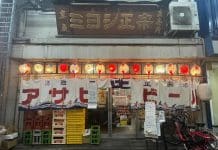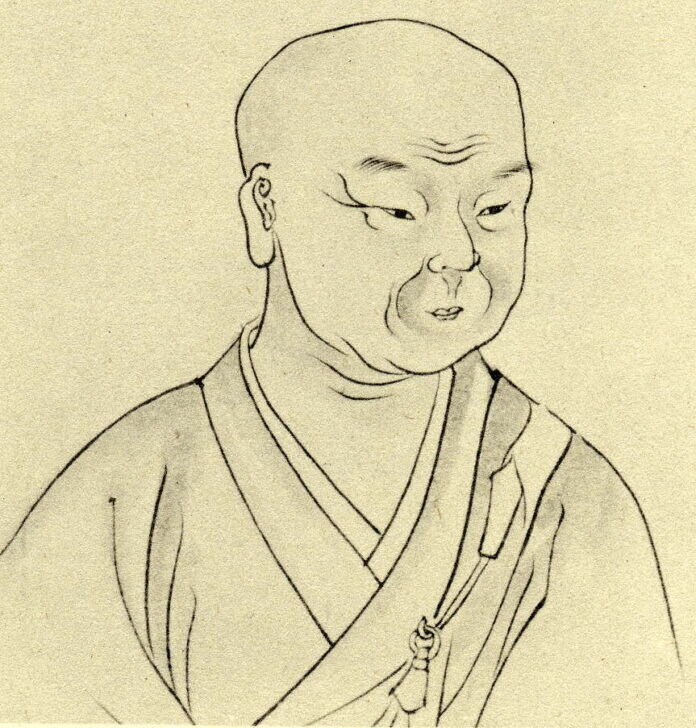
Osaka is a city famous for its food, comedy and mercantile background. Unsurprisingly, this means that much has been said about the history of Osaka’s culture and society, but on the other hand, relatively little has been written on the subject of the city’s intellectual history. This may be because the popular stereotypes of the people of Osaka – loud, brash, funny – do not particularly conjure up the image of a careful thinker. Of course, in reality it is not the case that Osaka has no intellectual history to speak of, as this essay aims to demonstrate. Taking a chronological path, we will first look at ancient and medieval history, where sources are scarce and philosophy was largely based around Chinese traditions like Buddhism, and then the early modern era, when relative stability across Japan created the opportunity for more varied ideas to gain traction. Nearer the arrival of Japan’s modern era, educational institutions in Osaka were vital to the development and spread of new knowledge and ideas, which would prove influential in the years that followed. Between the beginning of modern Japan and today, intellectuals in Osaka and elsewhere have explored many important subjects, including society, tradition and war. There have also been many valuable scientific discoveries, which will be examined in the final section. Though each part of the essay will look at only a small selection of representative figures, overall, this should provide some sense of what subjects have concerned thinkers in Osaka over its long history.
Table of Contents
Premodern thought in Osaka
Japanese history goes back millennia, and even the organisation of what we might recognise as a “nation” of Japan may have occurred as early as the 4th century CE.[1] Settlements in the area now known as Osaka existed in those early days, but for several reasons it is difficult to talk about thought in the area at that time. Partly this is due to a lack of records: until Chinese writing was brought to Japan via the Korean peninsula in around the 4th and 5th centuries and later adapted to suit the Japanese language, there was no form of writing in Japan.[2] Furthermore, literacy was not available to all, so for a long time writing was generally produced in the capital, which was, from the late 8th century, in Heian – modern-day Kyoto. However, from what is known about other knowledge imported from continental Asia, such as religion, it is possible to talk at least in general terms about the intellectual ideas of ancient and mediaeval Japan, and Osaka’s place in that world.
Most early philosophy in Japan was tied to religion, principally Buddhism, which was introduced alongside other knowledge and technologies from mainland Asia in the 6th century CE. Osaka is home to some sites of great importance to the early development of Buddhism in Japan, including Shitennoji, the first officially commissioned temple.[3] Shitennoji was founded on the orders of the regent Prince Shotoku, who employed many Korean and other Asian immigrants in such roles as political advisors and construction workers for the temple. However, though Shitennoji was important in the establishment of Buddhism as a state religion, the development of distinct schools of thought within Buddhism occurred further inland, in the Nara region, which was home to most of Japan’s early capitals.[4] Imperial authorities made significant efforts to regulate Buddhism during this time, but not all Buddhists supported the officially sanctioned schools, including the famous monk Gyoki. Possibly a descendant of immigrants from Korea, Gyoki was born in the 7th century in Kawachi Province – in what is today Sakai City – before leaving at the age of 15 to study at Asukadera in Nara.[5] His work as a monk left Gyoki dissatisfied, finding that mainstream Buddhism served merely to support the imperial court, without providing relief to people in need as he believed Buddhists should.[6] He eventually left his job at Asukadera, founding a temple in his hometown and embarking on a pilgrimage, during which time he aided the sick and the poor, and contributed to civil engineering projects. Evidence that his perspective was controversial can be seen in the fact that the government saw his ensuing popularity as a political threat and had Gyoki arrested.[7] In time, however, the government chose to harness his popularity instead, and he ended up becoming an influential figure, remembered for his involvement in the construction of Todaiji in Nara and dozens of the temples of the famous Shikoku Pilgrimage. For his philanthropic efforts, Gyoki was awarded the highest honour for a Buddhist priest, and after his death he was revered as a bodhisattva. His case shows that even in ancient times, heterodox philosophical views could gain traction outside of Japan’s political centre, but on the other hand, if he had not been part of that political centre himself for many years, it is possible that we may not have known of him. Therefore, this could be seen as an exception which proves the rule: that at that time, intellectual study had limited space for significant debate.
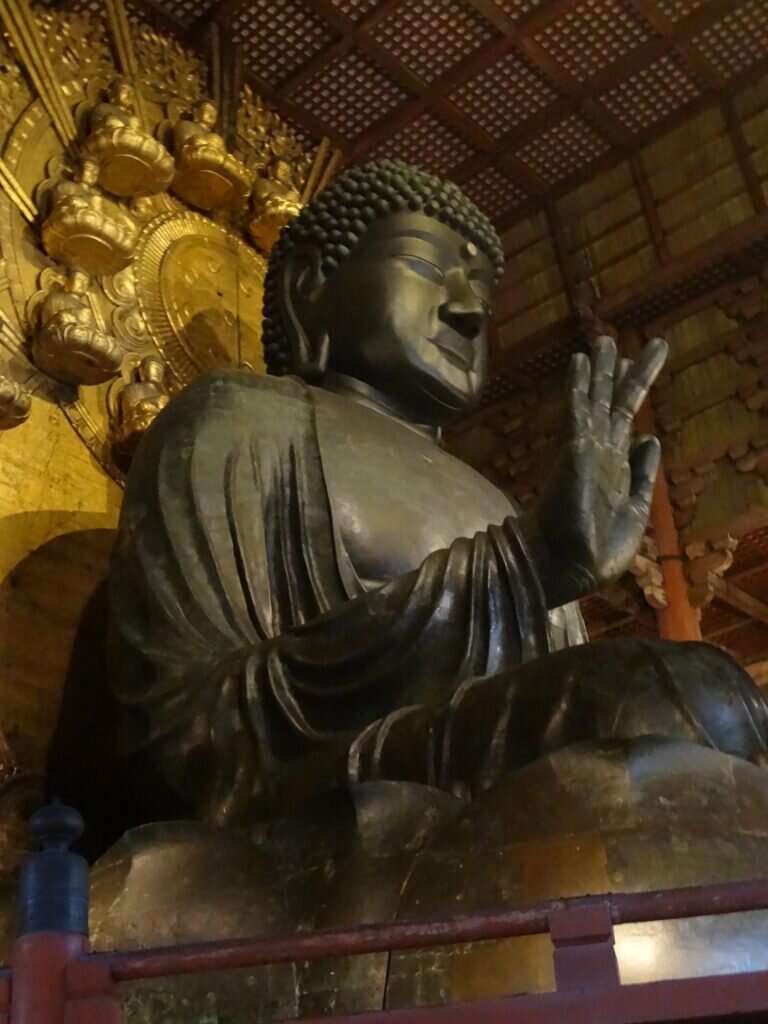
Culture and politics continued to move away from the Osaka area in the following centuries, first to Nara and then to the new capital of Heian. In Heian, intellectual pursuits flourished, particularly in the area of literature. During the Heian Period, which lasted from the time of the capital’s relocation until the point when the imperial court lost effective control over governance, great works of poetry and fiction were produced.[8] Apart from this, much of the writing produced in the classical era and the subsequent mediaeval era was connected with history or religion, and these works have been characterised as lacking in serious reflection or theoretical debate. What this period does show is that Buddhism was central to philosophy in Japan, as was Confucianism, another tradition borrowed from China. Confucian ideas influenced Japan’s laws and state rituals in important ways, though their initial implementation in the classical era had little effect on average people’s way of life.[9] Confucian ethics then gradually spread through mediaeval Japan, and new articulations of these ideas would go on to be important to the establishment of military governments, especially in the society of the Edo Period.
After many centuries where culture and philosophy were largely focused elsewhere, the most suitable point to begin looking more closely at the Osaka area is towards the end of the mediaeval era, when the city and the name of Osaka first appeared.[10] There are a few reasons for this. For one thing, this was the beginning of a growing permanent population there, as opposed to small settlements that rose and fell based on their relevance to people of authority. Also, at the time that Osaka was established, nearby Sakai was an important city, as the site of international exchange and trade, and as a rare instance of a city mostly independent of the many warring clans that shaped that period of Japanese history.[11] Furthermore, the mediaeval era soon gave way to the extended peace of the Edo Period, which enabled the development of philosophy distinct from religion, as well as providing the context for Osaka to emerge as an economic and cultural centre, where the values of the city’s huge merchant population held sway. Merchants were significant during the Edo Period in part because of the strict social system imposed near the end of the era of civil war preceding the Edo Period. Toyotomi Hideyoshi, one of the key figures in reuniting Japan at this time and the founder of Osaka Castle, promulgated this new system, which was informed primarily by Confucian ideals.[12] The system maintained the authority of the samurai class by placing them as the uppermost of four rigid castes; meanwhile, artisans and merchants were at the bottom, and only outcaste groups had a lower social standing. However, though their social position was ostensibly low, merchants had the chance to amass great wealth during the Edo Period, ultimately exposing the flaws in the social structure. Osaka, which became Japan’s primary economic centre, is therefore valuable in demonstrating the lifestyles and views of this social class.
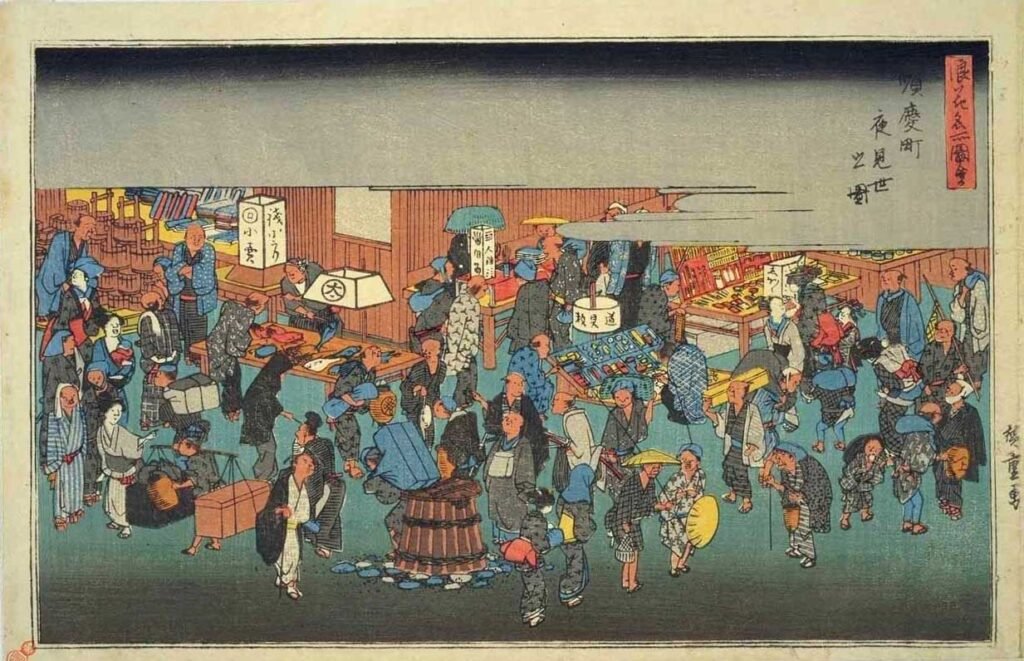
Source: Hiroshige.org.uk https://www.hiroshige.org.uk/Other_Views_Scenes/Other_Views_Scenes.htm
Examples of merchant values can be seen in the Edo Period arts of Osaka, including literature, drama and visual arts. Osaka poet and comic author Ihara Saikaku wrote many popular stories about merchants and their lifestyles in the 17th century, including works that at least purported to give practical and moral advice to merchants.[13] While the use of contradictory aphorisms and portrayal of amoral opportunism may have been on some level an ironic depiction of Edo Period merchants’ sneakier tendencies, his writing certainly paints a picture of the social changes occurring during that time. [14] Satire was a crucial element of his work too, with a frequent focus on settings where social conventions were upended, such as festivals, pilgrimages and the pleasure quarters of Japan’s major cities.[15] Monks were regularly portrayed as greedy and hypocritical, while both Buddhist and Confucian values were targets of ridicule. Though it is true that much of this was primarily for comic effect, Ihara’s status as one of the Edo Period’s most widely-read – if not exactly celebrated among the upper classes – authors suggests that the ideas expressed in his fiction struck a chord with merchant readers.
Another Osaka-based writer of roughly the same period was Chikamatsu Monzaemon, a bunraku and kabuki playwright renowned as the “Shakespeare” of Japan.[16] His plays were generally either historical dramas or contemporary tragedies, with the latter portraying the lives of ordinary people in Edo Period Osaka and often being based on true tales of lovers’ double suicides.[17] An important aspect of Chikamatsu’s value to Osaka’s intellectual history is his commentary on art and aesthetics. Naniwa Miyage, which records Chikamatsu’s remarks, was compiled by his close friend Ikan Hozumi, and remains a rare example of contemporary discussion of ukiyo (“floating world”), an aesthetic and lifestyle common in the work of popular writers of the time including Ihara Saikaku and many others.[18] According to Naniwa Miyage, Chikamatsu agreed with the predominant tastes in Osaka that derided extravagant acting and prioritised the more restrained wagoto style in kabuki theatre.[19] Nevertheless, rather than call for true realism in acting, Chikamatsu argued that a certain degree of fabrication is important to art, reportedly saying ‘Art is something that lies in the slender margin between the real and the unreal’. Between them, Ihara Saikaku and Chikamatsu Monzaemon give us a sense of the practical concerns and aesthetic preferences of Osaka’s growing merchant class in the Edo Period.
While Ihara Saikaku’s satire may give the impression that the traditional values of Buddhism and Confucianism were disregarded, Osaka was also home to some important thinkers associated with these areas. Perhaps most importantly, the initial founding of a town called Osaka can be attributed to the Buddhist monk Rennyo and his followers. A descendant of Shinran, the founder of Japanese Pure Land Buddhism, Rennyo revived Shinran’s ideas and played a vital role in accelerating the growth of the new sect in the 15th century.[20] Initially operating near Kyoto, Rennyo expanded the temple’s influence to the extent that he and his followers were forced by rival sects to move into the countryside. From there, he worked on compiling and updating Shinran’s teachings, and disseminating them in colloquial Japanese. Rennyo came into conflict not only with other Buddhist sects, but also with the political authorities, as his work inspired a series of armed rebellions by his supporters against local samurai lords, necessitating further relocations.[21] Rennyo’s final move took the sect from Yamashina, east of Kyoto, to a new site where they built the temple of Ishiyama Honganji. Rennyo died shortly after the move to Ishiyama Honganji, but not before dubbing the surrounding town “Osaka”.[22] His descendant’s efforts to resist the military forces of Oda Nobunaga, and Toyotomi Hideyoshi’s later choice to build Osaka Castle where Ishiyama Honganji had stood, were foundational for the development of the city of Osaka. Furthermore, though Rennyo’s involvement in political and military affairs faced some criticism, his work in spreading Shinran’s ideas enabled the Pure Land sect to grow from a tiny movement into one of the major schools of Japanese Buddhism.[23] Other important Buddhist figures in this period include Keichu, a priest and scholar whose influence on other schools of thought will be discussed in more detail in the next section.
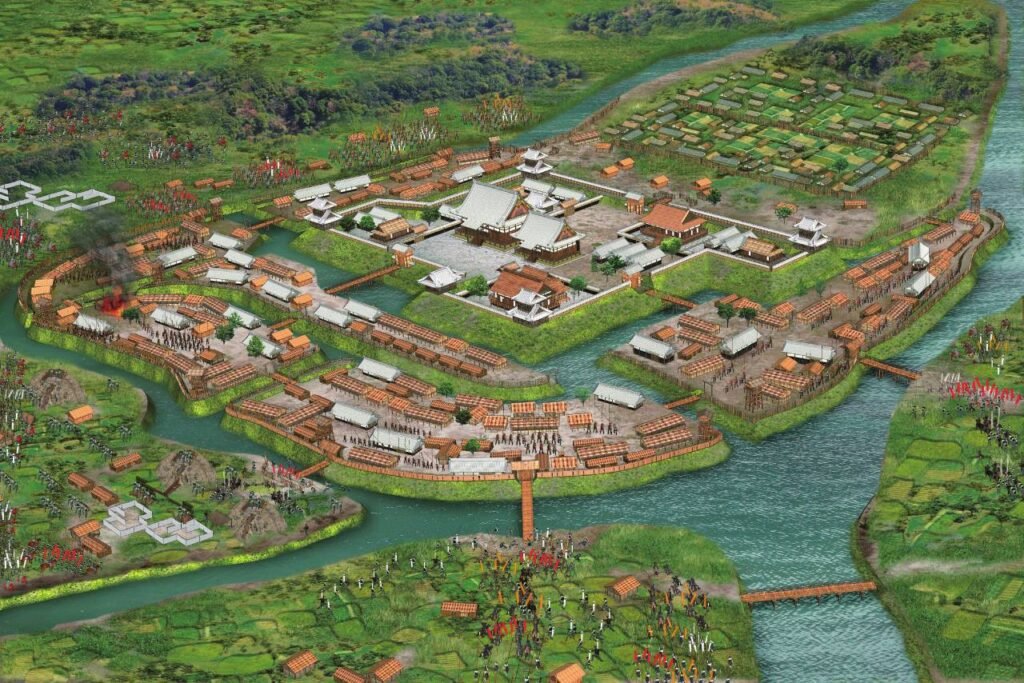
Source: Rekishijin https://www.rekishijin.com/3222
As the basis of the Edo Period social system, Confucian philosophy was of course widely influential in this era as well. Mainstream thought interpreted the Confucian emphasis on a ruler who sets a moral example for their subjects as supporting the samurai establishment, with criticism being mostly limited to a conservative style that admonished disloyalty and heterodoxy. Other branches of Confucian thought were sometimes strongly suppressed, but they did exist, showing how opposition to the prevailing social order could come even from followers of Confucian values, such as in the case of Oshio Heihachiro.[24] Oshio was a policeman of the samurai class in the early 19th century, near the end of the Edo Period. Through his work, he gained a reputation for uprightness and zeal, importantly turning his attention towards the corruption he saw in Osaka. Especially after retiring from the police, his experience led him to move away from the standard model of Confucian thought to yomeigaku, a relatively popular alternative branch based on the ideas of Wang Yangming, which emphasised intuition, introspection and action.[25] Oshio rejected the social distinctions of mainstream Japanese Confucianism and favoured egalitarian ideals, though he too had a tendency towards paternalistic elitism; moreover, he also placed importance on intuitive action. These ideals, and his sympathy for peasants during a period of frequent famine in the 1830s, inspired him to seek government support for people in need and, after being rejected, to instigate a revolt in 1837. The peasant uprising was quashed quickly, but only after around a quarter of the city was destroyed.[26] Following the failure of the revolt, Oshio was surrounded by government forces and took his own life. Though his efforts ultimately came to nothing, the event inspired further action around the country, reflecting general discontent with food shortages and economic hardship. Oshio’s sincere idealism would later turn him into a figure of inspiration for people across the political spectrum, including leftists who saw him as a champion of the poor, and nationalists who regarded Oshio as a powerful symbol of the Japanese character. Perhaps most crucially in the context of this essay, his example shows that in the late Edo Period, there was an appetite for new ideas that did not conform to Buddhist and Confucian tradition, more of which will be explored in the following section.
Moving towards modernity
As Oshio Heihachiro’s revolt and the circumstances in which it took place demonstrate, the social order of the Edo Period was under great pressure by the 19th century. Indeed, within a few decades of the uprising in Osaka, the military government was abolished, the emperor’s political authority was restored and a new Tokyo government dominated by former samurai from the provinces in Kyushu pursued rapid modernisation. These huge political and social changes make the later years of the Edo Period especially interesting in hindsight. By looking at some of the ideas that developed at this time, we can see how the country was already being pulled in seemingly contradictory directions: while some advocated a nativist perspective, others attended new educational institutions to proactively study knowledge from the Western world.
One major intellectual trend that grew throughout the Edo Period and became influential on modern Japan was kokugaku, or “national learning”. Kokugaku thinkers stressed the importance of studying Japan’s ancient past, such as native mythology and literature, and increasingly they sought to separate Japanese traditions from imported ideas like Buddhism and Confucianism.[27] This would result in an ethnocentric and essentialist point of view, which became widespread in Japan’s modern era and contributed to the nationalism of the late 19th and early 20th centuries, even before international relations expanded.[28] The roots of this intellectual movement lie earlier though, with the figures who inspired prominent kokugaku writers. One of the most significant forerunners was Keichu, a 17th-century Buddhist priest from Amagasaki, then part of Settsu Province.[29] Through his career, he worked in several temples in and around Osaka, where he concentrated his efforts on the study of Japanese classical poetry. Keichu approached these texts in a then-innovative empirical manner, examining the old Japanese language and its phonetic shifts, and thereby revolutionising Japanese linguistics.[30] In his commentaries, he drew attention to the differences between Japan’s native Shinto religion and the Chinese traditions of Buddhism and Confucianism.[31] This in particular made Keichu an important point of reference for later writers like Motoori Norinaga, who stressed the superiority of Japanese traditions over the likes of Buddhism. Though these thinkers tended to downplay Keichu’s status as a Buddhist priest and his reference to esoteric Buddhist ideas in his work, with some opting to discount his contribution as a result, Keichu’s groundbreaking studies of classical literature and language were vital in pioneering what would become kokugaku.

Source: Osaka 21st Century Association https://www.osaka21.or.jp/web_magazine/osaka100/023.html
During the heyday of kokugaku, Osaka was second only to Edo – the seat of the military government that would later be renamed Tokyo – among Japan’s major cities. As such, it was a meeting ground for many intellectuals of the time. One well-known writer and scholar in Osaka was Ueda Akinari, a contemporary of the representative kokugaku figure Motoori Norinaga. Ueda was known in the region as an author and poet, and in his early years he wrote comic fiction along the lines of Ihara Saikaku, in which he satirised the social order of the 18th century.[32] In the 1760s, he shifted his focus to kokugaku scholarship and studied classical Japanese literature in great depth, which soon brought him into public conflict with Motoori. Ueda critiqued Motoori’s insistence that studying ancient texts could reveal history exactly as it really was, arguing that the relationship between oral and written language was more complex than Motoori believed, and that classic texts of Japanese mythology should be interpreted metaphorically and not literally.[33] Furthermore, he suggested that Motoori’s assertion of Japan’s primacy in the world amounted to the same cultural chauvinism that kokugaku thinkers aimed to resist by eschewing Chinese traditions. This high-profile debate and the eventual popularity of Motoori’s ideas may have dampened Ueda’s enthusiasm for kokugaku thought; today he is better known not for his scholarly writings but for his collections of supernatural tales, Tales of Moonlight and Rain (Ugetsu Monogatari) and Tales of Spring Rain (Harusame Monogatari).[34]
After Ueda, and nearer the end of the Edo Period, another kokugaku writer active in Osaka was Hagiwara Hiromichi. Hagiwara was born into a low-ranking samurai family in Okayama in the early 19th century and soon developed a passion for classical poetry.[35] He later moved to Osaka to evade obligations to his home domain in Okayama, and quickly joined the local intellectual scene, writing essays on varied topics and delivering lectures on Murasaki Shikibu’s Heian Period classic The Tale of Genji (Genji Monogatari). This led him to begin a project to publish a new edition of Genji, featuring commentary intended to make the work accessible to all. To this end, he incorporated not only the kokugaku perspective of his contemporaries, but other philosophies too. The first two volumes were well-received before his untimely death and the end of the Edo Period. After this, his Genji commentary was largely overlooked in favour of the likes of Motoori Norinaga, largely due to Hagiwara’s eclectic influences, which became less fashionable as intellectuals of the modern era prioritised views espousing Japanese superiority. Though both Ueda Akinari and Hagiwara Hiromichi were well-known and successful kokugaku scholars in their day, it is perhaps their willingness to depart from the philosophy’s more nationalistic tendencies that caused their names to largely disappear in the time since.
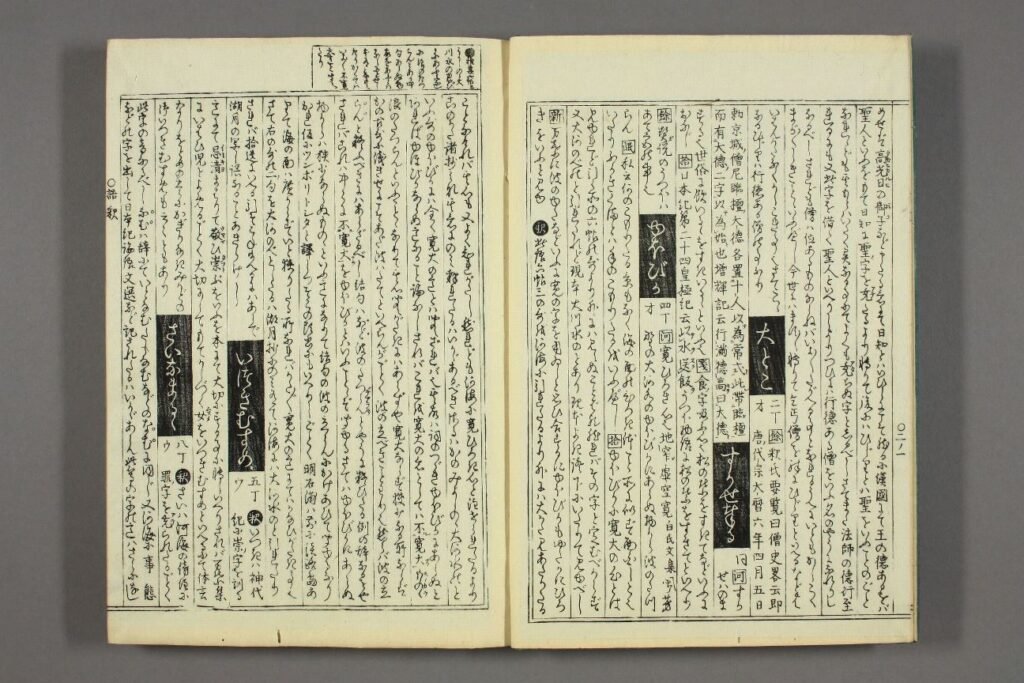
Source: Waseda University Library https://www.dh-jac.net/db1/books-e/results1024.php?f1=bunko30_a0158_0012&f12=1&enter=portal&max=1&skip=4&enter=portal#
In the Edo Period, places of learning spread throughout Japan, but generally there were different schools for children of each social class, and higher education was limited.[36] However, this began to change, with two pioneering schools of higher learning being established in Osaka in the 18th and 19th centuries. The first of these was the Kaitokudo, founded in 1724 and officially recognised by the government in 1726.[37] The Kaitokudo was established by and for merchants, as were many smaller academies at the time, but this government recognition set it apart from others as a protected institution with significant status. It began as a place for the study of the Confucian classics, from which early teachers drew to develop the idea that any human is inherently capable of virtue and of learning, and that merchants’ commercial activity is no less morally sound than the behaviours of any other social class.[38] As such, those who ran the school had a relatively egalitarian outlook and made education available to anyone who sought it.
Among the Kaitokudo’s most famous figures are the Nakai brothers Chikuzan and Riken, sons of one of the academy’s founders. The brothers followed their teacher Goi Ranju in openly criticising the ideas of the influential Confucian scholar Ogyu Sorai, who represented the establishment view of the samurai class as morally and intellectually superior.[39] Chikuzan in particular was one of his harshest critics, questioning Ogyu’s interpretations of Confucian texts and insinuating that he was motivated by a personal desire to address perceived slights.[40] Besides this notable publication, Chikuzan is also known for a letter he wrote to a prominent feudal lord on the subject of Japan’s economy. He proposed greater centralisation and reform of the existing system whereby local lords were required to spend alternate years in Edo, as well as a unified education system. Meanwhile, Riken was known to be quite different from his brother Chikuzan, spending his time away from the Kaitokudo itself and working on commentaries on Confucian classics. Though he tended to avoid direct involvement in politics, there were exceptions, such as a critique of government policies on crime and punishment; like Chikuzan’s economic arguments, this was based in large part on his merchant background.[41] In these ways, Kaitokudo scholars like the Nakai brothers synthesised Confucian fundamentals with the specific experiences and values of the merchant class.
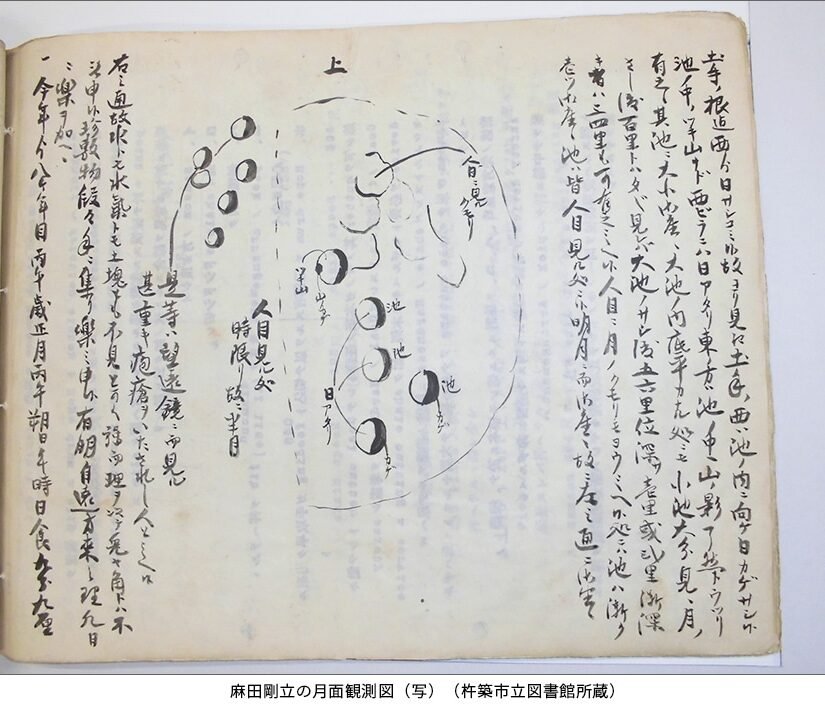
Source: Osaka 21st Century Association https://www.osaka21.or.jp/web_magazine/osaka100/013.html
Though Confucian studies were at the heart of the philosophy of the Kaitokudo, scholars’ areas of study were eclectic, and came to prioritise the empirical study of nature, effectively developing a scientific perspective. Astronomy was a subject which piqued the interest of many at the Kaitokudo, including Nakai Riken, as well as such influential figures as the teacher Asada Goryu. Asada Goryu was an important astronomer in the late 18th century, a time when traditional Chinese astronomical models were being challenged as rangaku – “Dutch studies” – brought new scientific knowledge from the Western world.[42] Asada did not entirely abandon Chinese astronomy, but he was also influenced by the writings of Jesuits in China, and placed great emphasis on testing theories through observation. After the hereditary government astronomers miscalculated a solar eclipse, revealing the flaws in their calendar system, the government sought out Asada to develop a new calendar. Though he refused the position himself, two of his protegees went to Edo in his place; their revised calendar, the first in Japan to make use of Western methods, was completed in 1797 and adopted the following year.[43] Asada’s ideas and experiments were vital in the development of astronomy in Japan, and today a crater on the moon bears his name.[44]
Besides the two who developed the new calendar in the 1790s, another of Asada’s pupils was Yamagata Banto, a merchant, Confucian scholar and astronomer who helped to popularise the heliocentric theory in Japan.[45] The rationalism of heliocentrism and other concepts from rangaku, combined with his views on Confucian values, contributed to Yamagata’s promotion of atheism. He was not the Kaitokudo’s first scholar to voice such opinions though: an early student at the academy was Tominaga Nakamoto, an iconoclastic scholar of religious systems who rejected not only Buddhism and Shinto, but Confucianism as well.[46] The latter point resulted in Tominaga’s swift expulsion from the academy, but his willingness to fundamentally criticise Japan’s main schools of thought influenced thinkers as varied as Yamagata Banto and kokugaku figures like Motoori Norinaga.[47] Though Confucianism informed Yamagata’s ideas to a great degree, he too came to the conclusion that religion is irrational, detailing his argument against the existence of gods over two chapters in his most famous work Instead of Dreams (Yume no Shiro).[48] Though his criticism of Shinto proved to be controversial after Japan’s modern era began, his work eventually received attention again, and since 1982, the Osaka Prefectural Government has recognised his influence by offering the annual Yamagata Banto Prize to writers who contribute to international understanding of Japanese culture.[49]
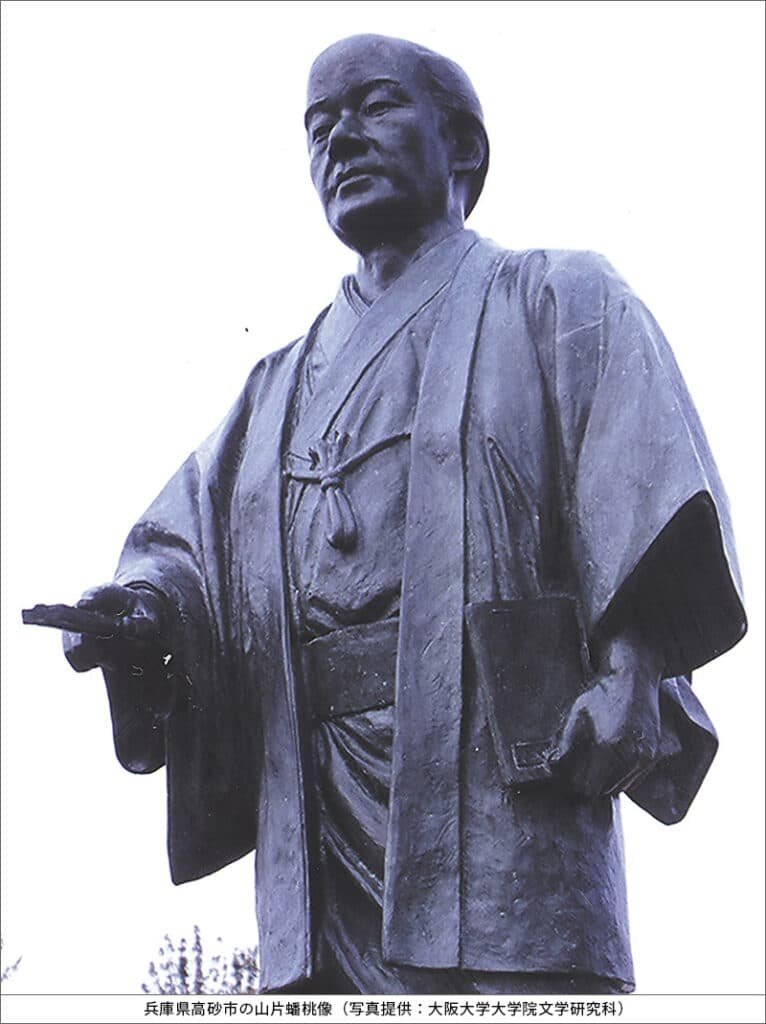
Source: Osaka 21st Century Association https://www.osaka21.or.jp/web_magazine/osaka100/087.html
Osaka’s other famous school of the Edo Period was founded over a century after the Kaitokudo. In 1838, physician Ogata Koan opened Tekijuku, an academy for the study of medicine and other sciences, only minutes away from the Kaitokudo in the Senba district.[50] This school was similar to the Kaitokudo in that students of all social backgrounds were welcome. Among those who studied there are a number of famous names, including Ogata Koan himself. He is remembered particularly for his contribution to medical ethics, with his idea that all patients should be seen simply as patients, regardless of class or rank, and for his work in combatting some of the 19th century’s most troubling diseases.[51] One of his most important achievements was the establishment of a vaccination centre in 1849, where Ogata and fellow doctors administered the smallpox vaccine. He also played a key role in improving public health practices during a cholera epidemic affecting Japan in the 1950s.[52] As well as translating medical texts from Dutch into Japanese, he published a book of guidelines on hygiene and treatment of the disease. His valuable work was soon recognised by the government, who summoned him to Edo to work as an official advisor, but he died not long after his arrival there. However, the contributions he made to medicine in Japan were vital at a time when people were more eager than ever to apply scientific knowledge from the Western world.
Perhaps Tekijuku’s best-known alumnus is Fukuzawa Yukichi, one of Japan’s most influential thinkers following the Meiji Restoration of 1868. Fukuzawa studied under Ogata Koan between 1855 and 1858, learning Dutch in order to access Western knowledge.[53] While his time at Tekijuku was brief, studying in Osaka was something that Fukuzawa saw as important. In his view, rangaku scholars in Edo were motivated only by the professional benefit of studying foreign languages and texts, whereas those in Osaka, who sought knowledge for its own sake, had a greater level of ethical integrity; for this reason, many students travelled to Osaka from around the country, but relatively few travelled to Edo.[54] His ideas were also influenced by the other intellectuals around him in Osaka, such as Nakai Riken. After having studied at Tekijuku, Fukuzawa began learning English and participated in the first Japanese missions to the United States and Europe, which further persuaded him of the benefits of spreading ideas from the West in Japan.[55] He also founded a school in Edo that would become Keio University, Japan’s first private university, and Jiji Shinpo, an influential newspaper. Before and after starting Jiji Shinpo in 1882, he wrote prolifically on a huge variety of subjects, constantly emphasising the value of independence and education. In Fukuzawa’s eyes, Japan and other Asian countries lagged behind the West, and so studying Western science and ideas was beneficial both to the individual and to the nation, though he also stressed that simple imitation was insufficient.[56] As such, he opposed traditional values, instead promoting ideas such as individual liberty, a politically independent intellectual sphere, and women’s rights. Some of his writings have since proven controversial, especially ones advocating that Japan “depart” from Asia in favour of Western-style modernisation. Nevertheless, his forward-thinking ideas inspired people in government, other intellectuals and the general public, and although he always refused to enter politics himself, his influence had a lasting impact on modern Japan.
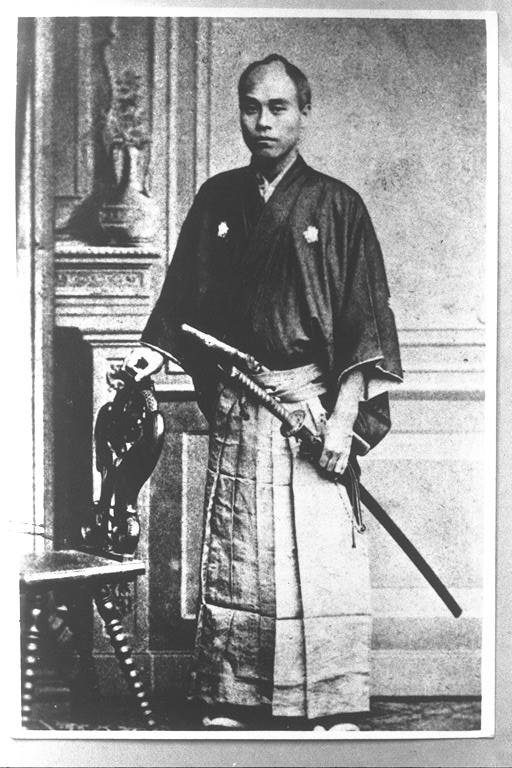
Source: Wikipedia https://commons.wikimedia.org/wiki/File:Yukichi_Fukuzawa_Berlin.jpg
Towards the end of the Edo Period, two of the major academic fields were kokugaku – a school of thought that looked at Japan’s past and increasingly shunned outside influence – and rangaku – the study of scientific developments from truly foreign parts of the world. Especially when it comes to rangaku, Osaka had a central role, as home to two merchant academies that produced prominent thinkers in science, medicine and philosophy. Even apart from those described above, many other important intellectuals attended or had correspondence with either the Kaitokudo or Tekijuku. These individuals contributed to scientific knowledge and shaped debate in Japan in many ways as the country’s modern era approached. Osaka gained a reputation for independent thinking, fostered by merchant-run institutions that championed learning for the sake of learning, with less concern for personal professional benefit; it was in this environment that pioneering thinkers like Yamagata Banto and Fukuzawa Yukichi developed ideas that ran counter to tradition. At the same time, however, kokugaku philosophy had an impact, resulting in, for example, the separation edict of 1868 which removed Buddhist elements from Shinto, paving the way for the politicised “State Shinto”.[57] The tension between national tradition and modernisation would therefore continue beyond the Meiji Restoration and affect public debate for years to come.
Intellectual trends in the modern era
As previously discussed, in the time before and after the huge political and social upheaval of the Meiji Restoration, a variety of ideas were being explored, responding in one way or another to the collision of Japanese “tradition” and mostly Western “modernity”. One result of this, as seen in some of Fukuzawa Yukichi’s ideas, is the development of liberal philosophy in Japan. A prominent figure in this movement was Nakae Chomin, who studied in France as part of one of the same diplomatic missions that Fukuzawa joined, and became known for translating and popularising the works of thinkers like Rousseau.[58] Upon returning to Tokyo, Nakae began launching several newspapers and magazines, in which he disseminated liberal concepts and criticised the government.[59] The latter point led to his being exiled from Tokyo, after which he moved to Osaka, where he continued to publish translations and commentaries, and briefly pursued a political career. Nakae’s difficult relationship with the central government provides an early example of how, despite the dismantlement of the Edo Period social hierarchy, democratic values were not always supported by the new regime.

Source: Wikipedia https://en.m.wikipedia.org/wiki/File:Asahi_Shimbun_first_issue.jpg
Besides the challenges facing liberal thinkers at the beginning of the modern period, Nakae’s case also demonstrates the significance of newspapers as a platform for intellectuals during this time. One major example was the Osaka Asahi, which was established in 1879 and soon followed by a Tokyo edition.[60] Today, as the Asahi Shimbun, it is a national newspaper, regarded as having a liberal editorial stance, as was the case in its early days too.[61] Its ranks included the influential writer Hasegawa Nyozekan, a frequent critic of the national government who eventually resigned from the Asahi together with most of the editorial board, in protest against government threats to suspend the paper for opposing the official response to the 1918 Rice Riots in Osaka.[62] Following the incident, Hasegawa founded a new magazine with many of his former Asahi colleagues to promote journalistic freedom, and published critiques on domestic politics and on fascism. The Asahi is also notable for the serialisation of many popular novels, especially in genres like historical fiction and melodrama.[63] This popular fiction demonstrates the different taste of readers in Osaka in comparison with those in Tokyo, where early 20th-century newspapers tended to publish more highbrow literature; however, the types of novel published in Osaka would turn out to be popular nationwide, and created many cliches that later made their way to film and television. Newspapers like the Asahi are informative as they show not only the political leanings of intellectuals in Osaka, but also the everyday interests of the citizens.
An increasingly important subject for writers after the Meiji Restoration was the position of women in Japan’s new social order. An influential early figure in this area was the poet Yosano Akiko, born in 1878 in Sakai.[64] Her poetry attracted attention quickly, with her debut collection Tangled Hair (Midaregami) defying convention by mixing religious metaphors and sexuality, and her anti-war poem Thou Shalt Not Die (Kimi shinitamo koto nakare) proving controversial during a time of rising militarism.[65] She also wrote about social issues and education, and was associated with Bluestocking (Seito), a literary magazine promoting women’s rights, which featured one of Yosano’s poems in its inaugural issue.[66] Besides challenging poetic traditions and discussing serious political matters, Yosano also had a keen interest in classical literature, frequently writing in the traditional tanka form and producing a translation of The Tale of Genji into modern Japanese. An interesting connection to Osaka’s intellectual past can be seen in relation to this: after being shown folding screens bearing Genji-inspired poetry by Ueda Akinari at the home of Hankyu railway tycoon Kobayashi Ichizo, she was inspired to write similar poems of her own.[67] Through Bluestocking and her other writings, Yosano became an important influence on Japanese feminism, while works like the Genji translation also made her a key figure in modern literature. Though Osaka was otherwise not a particularly major centre for early feminists in Japan, its position as one of the country’s biggest cities made it a valuable site for promoting new ideas. For example, Kishida Toshiko, a woman who became famous for political speechmaking, gave her first public speech in Osaka in 1882.[68] For this and later speeches, Kishida received some praise, but also criticism and ridicule, and the next year, she was arrested for the supposedly inflammatory content of her famous ‘Daughters in Boxes’ speech. Her example is seen as atypical for the time, but she nevertheless served as an inspiration to others, who followed in her footsteps and tested the boundaries of what women could achieve in this new era.
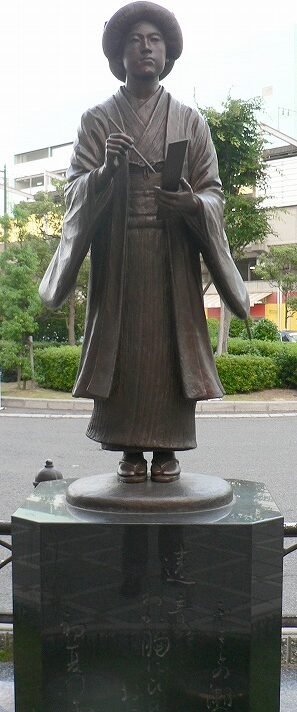
Source: Wikipedia https://commons.wikimedia.org/wiki/File:Yosano_Akiko(bronze_statue).jpg
As Yosano Akiko’s work with The Tale of Genji shows, even for forward-thinking individuals, Japanese traditions were a subject of interest, and the fact that they were being challenged by modern innovations often served to highlight the contrast between old and new Japan. Novelist Tanizaki Jun’ichiro, one of the most celebrated Japanese writers of the 20th century, moved from Tokyo to the Kansai area after his home in the capital was destroyed in the Great Kanto Earthquake of 1923; it was after this relocation that he produced his most famous works.[69] Apart from novels dealing with the tension between the traditional culture he witnessed in and around Osaka and the increasing cosmopolitanism of the present day, Tanizaki also wrote at length on the subject of aesthetics. In the 1933 essay In Praise of Shadows, (In’ei raisan), he emphasised the significance of shade and ambiguity in Japanese arts, juxtaposing this with the likes of electric lighting, a representative example of a modern zeal for constant improvement and importation of Western technology.[70] He wrote on the subject of the Japanese language as well, arguing in In Praise of Shadows that literature offers a means to pursue aesthetics for its own sake, and elsewhere that the standardised modern language was inorganic and derivative of Western languages. Later, Tanizaki addressed fading traditions again in The Makioka Sisters (Sasameyuki), perhaps his best-known novel. Through the story of a family from Osaka’s traditional Senba district, this novel depicts the decline of traditional practices and values in the face of modernity, not only in the form of Western influence, but also the increasingly Tokyo-centric and nationalistic vision of Japan.[71] In many ways, Tanizaki’s works, both in fiction and in commentary, demonstrate the difficulties that writers saw in the modernisation of Japan.
Of course, we now know that the pursuit of progress, militarism and nationalistic fervour would result in imperialism and world war. There was some dissent among intellectuals during the 1930s, but for several reasons, those voices grew quieter as time went on. Many of the liberal intellectuals who had warned of increasing political violence earlier in the 20th century lacked a response when it came to violence carried out by the state, and came under pressure to refrain from speaking out.[72] Their perspective fell by the wayside as some writers were censored, some cooperated with the state and some underwent tenko, whereby they were compelled to recant views contrary to the state’s goals. The notion of “modernity” had been challenged by public intellectuals before, but in this period it was clear that the specific target of criticism was Western values and influence, and even former advocates of democracy like Hasegawa Nyozekan and Yosano Akiko ended up justifying Japanese imperialism.[73] As a result, there was no space for debate at this time; no intelligentsia free from political influence as people like Fukuzawa Yukichi had hoped. Collusion with the state destroyed the reputation of some intellectuals, but others returned to prominence after the war, including Hasegawa, whose prewar writings on the Japanese national character have been suggested as a form of subtle dissent, wherein he implied that militarism was not in line with Japanese tradition. He would return to this kind of study in the postwar era, looking into Japan’s past specifically to find indigenous arguments for democracy and thus argue that it was not an exclusively Western concept.[74] He also had an influence on at least one leading postwar intellectual, the Osaka-born Maruyama Masao, whose father was a close friend of Hasegawa’s and had been part of the group resignation from the Osaka Asahi in 1918. Though sympathetic to Marxists in the postwar debate, Maruyama was not entirely in agreement with them in theoretical terms, instead seeking, like Hasegawa, to define democracy in Japanese terms and justify it as a universal concept.[75] This was just one of the ways in which thinkers after the Second World War responded to the war itself and the ideas that led to it.
The legacy of the war was important to many Osaka writers thereafter, not least because the city had been so severely damaged by it. They belong to the “yakeato (burnt-out ruins) generation”, that is, people born in the 1930s, who were children living in Japan during the bombing campaigns towards the end of the war.[76] Oda Makoto, a popular author and political activist who lived through the fire-bombing of Osaka, is a representative example. His experience led him to try to understand the apparent senselessness of war, writing on how war forces individuals to become both victim and victimiser, and to dehumanise others.[77] Another influence was his travels through Asia, where he developed a great appreciation for cultural diversity at a time when mainstream society largely overlooked cultures other than Japan and the Western world. As a result of these experiences of indiscriminate violence and of varied cultures, Oda stressed the notion of peace as a universal principle and applied this to his writings and his political activities. Among Oda’s contemporaries was Kaiko Takeshi, a reporter and author who, together with Oda, was involved in the anti-Vietnam War movement Beheiren.[78] He shared Oda’s concerns about the meaninglessness and dehumanising nature of war, exploring these themes in novels partially based on his experiences as a newspaper correspondent in Vietnam.[79] In contrast, Kaiko often wrote about food and drink later in his career, but even in culinary writings there was social commentary, including satire of consumerism.[80] Others who often spoke out about war include the essayist Okabe Itsuko, who was also inspired by her wartime experiences, specifically her painful memories of sending her young fiancé away to fight and eventually die, knowing that he disagreed with the war.[81] This led to a point of view similar to Oda’s, challenging the distinction between victim and aggressor, and drawing attention to the complicity of ordinary people in the war. In many writings and speeches, she vigorously opposed war throughout her life. All three of these individuals, and others like them, demonstrated a willingness to criticise not only the Second World War and the ideologies involved in it, but also people’s failure to truly reflect on its significance.
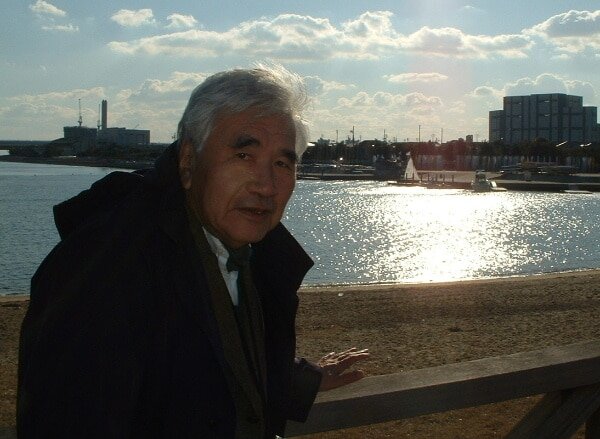
Source: San Francisco Bay Area Independent Media Center https://www.indybay.org/newsitems/2006/03/14/18076761.php
It is only natural that Japanese imperialism, the Second World War and the war’s aftermath had a profound impact on thought throughout the 20th century and beyond, and that is why these topics have been given particular attention. However, in modern Osaka as in the premodern era, thinkers have explored a great variety of other subjects too. These include areas that have been studied for centuries, like religion. Abe Masao, perhaps the most prominent Buddhist scholar in postwar Japan, was born in Osaka, and it was as a student at Osaka Municipal University that he explored texts that later drove him to move from Pure Land to Zen Buddhism, the school he would be famously associated with.[82] He was later celebrated for a huge array of work, including translation of important texts, disseminating Zen ideas outside Japan, and initiating crucial interfaith dialogue.[83] While the history of Buddhist studies goes back to the very earliest philosophy in Japan, contemporary issues have also emerged. Some of these were explored by the author Komatsu Sakyo and other individuals involved in the thematic planning of Osaka’s famous international exposition of 1970, as well as by people who protested against the expo.[84] They dealt with topics such as peace and shared humanity, much like many other postwar thinkers, but also new concerns like environmentalism. Even more recently, trends in contemporary society have opened new academic avenues. For example, former anime producer Okada Toshio achieved great success writing books on anime fan culture and even ran a course on the subject at the prestigious Tokyo University.[85] Interestingly, a major childhood influence on Okada and his old colleagues was Expo ’70, which inspired visitors with the futuristic design of its architecture and especially the exhibition of a moon rock at the United States pavilion.[86] These examples show not only the variety of ideas being explored in modern Osaka, but also some of the connections between thinkers through the ages. Just as religious scholars like Abe Masao have a link to ancient traditions, writers of more popular subjects are connected, through Expo ’70, to the postwar search for peace and a hopeful future.
Science in Osaka
The previous section explored some of the major intellectual trends of Osaka in the modern era, especially in the 20th century. In many cases, a clear link can be seen between these modern topics and the ideas of late-Edo Period thinkers like Fukuzawa Yukichi and others in the rangaku and kokugaku fields. However, an important aspect of academic developments in Fukuzawa’s time was science and medicine, as demonstrated by the likes of Asada Goryu and Ogata Koan; naturally, this scientific progress did not end as Japan entered its modern era. This section will briefly look at some of the leading scientists to have lived and worked in Osaka, and their important contributions to modern science.
First, several of Japan’s Nobel-winning scientists were either born or studied in Osaka, including the theoretical physicist Yukawa Hideki. Though Yukawa spent most of his life in Kyoto, where he attended university, it was during the years where he worked in the physics department of the then-new Osaka University that he published his groundbreaking 1935 paper proposing the existence of subatomic particles called mesons.[87] Soon, Yukawa and other physicists around the world began testing the theory, and though there were some initial setbacks, his predictions were eventually vindicated. In 1949, he became Japan’s first recipient of the Nobel Prize in Physics. He later joined other Nobel laureates in signing the Russell-Einstein manifesto, a declaration calling for nuclear disarmament.[88] In the 1940s, when meson theory was popularised overseas, Yukawa’s status as a prominent Japanese physicist had an impact on others in Japan, such as Nambu Yoichiro, who was a student at the time.[89] Like Yukawa, Nambu was not from Osaka, but he spent many years working there as a professor at Osaka City University, and returned to the area from the United States in his retirement.[90] His identification of a subatomic mechanism called spontaneous broken symmetry, which helps to explain why symmetrical states are suddenly undone, won him many awards, eventually culminating in the Nobel Prize in 2008, which he shared with two other Japanese physicists who had later developed his theory.[91]
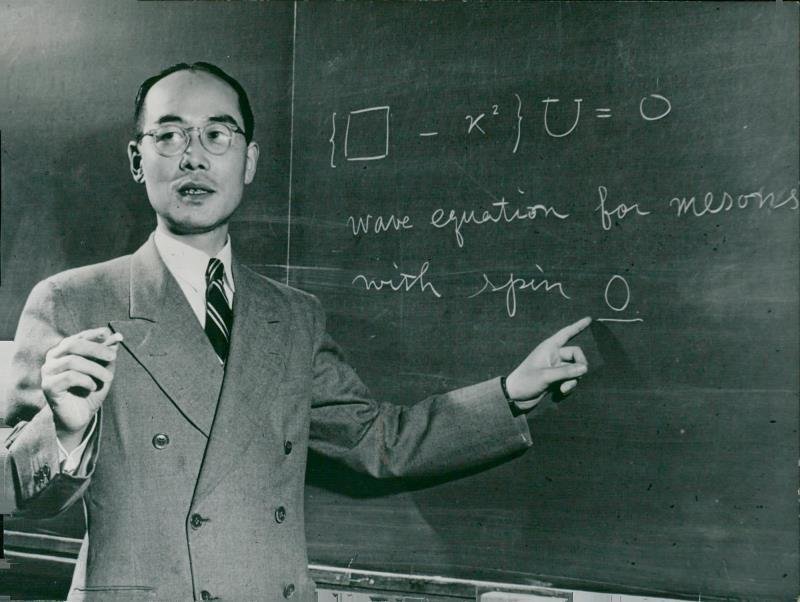
Source: Wikipedia https://commons.wikimedia.org/wiki/File:Hideki_Yukawa_1949c.jpg
In the past decade, two scientists from Osaka Prefecture have been awarded the Nobel Prize. In 2012, Yamanaka Shinya received the Nobel Prize in Medicine for his revolutionary development of the earlier stem cell research of John B Gurdon, with whom he shared the award.[92] Specifically, Yamanaka succeeded in reprogramming mature cells to produce pluripotent stem cells, an important step forward in a field that had struggled with the controversy of working with human embryonic cells.[93] Later, the 2019 Nobel Prize in Chemistry went to Yoshino Akira for his decisive developments in creating the first effective lithium-ion battery in the 1980s; again, the award was shared with other scientists who had worked on the technology before him.[94] Yoshino attributed his achievements to his willingness, as somebody lacking experience in the battery technology field, to defy convention and use materials that others would have overlooked. These rechargeable batteries, which presaged the kind used today in all manner of electronics, were recognised by the Nobel committee as helping the environment by reducing reliance on fossil fuels.[95] Groundbreaking developments like Yoshino’s and Yamanaka’s may therefore change our world for the better.
High-profile prizewinners like Yamanaka Shinya have helped to give Osaka a strong reputation in science. During the city’s eventually successful bid to host another World Expo in 2025, the organisers made use of this by recruiting Yamanaka to speak at a presentation, where he noted Expo ’70 as a childhood inspiration.[96] Yamanaka represents Osaka’s prominent biology field, which traces its origins to Tekijuku, one of the forerunners of what would become Osaka University.[97] Other famous names in this area include Kishimoto Tadamitsu and Hirano Toshio, two immunologists who worked together in identifying interleukin 6, a protein associated with a number of autoimmune and other diseases.[98] Both Kishimoto and Hirano have served as president of Osaka University.[99] Another prominent immunologist, Akira Shizuo, worked under Kishimoto for several years, and after moving into the specific area of innate immunity, he was involved in huge advances in that field, including rethinking its relationship with adaptive immunity, with implications for vaccine development.[100] The prolific work of Akira and his colleagues soon made him one of the world’s most frequently cited scientists.[101] Researchers at institutions in Osaka have also been involved in a variety of other important developments in biology. These include Yoshizumi Ishino, who accidentally discovered strange DNA sequences, later called CRISPR (Clustered Regularly Interspaced Short Palindromic Repeats) with his Osaka University colleagues in 1987.[102] Its potential for genome editing later made CRISPR a popular subject for research, and eventually the 2020 Nobel Prize in Chemistry went to Emmanuelle Charpentier and Jennifer Doudna, who successfully produced “genetic scissors” enabling relatively easy modification of genes, with major implications for preventing serious illness.[103] Only time will tell how these discoveries might revolutionise medicine as we know it.
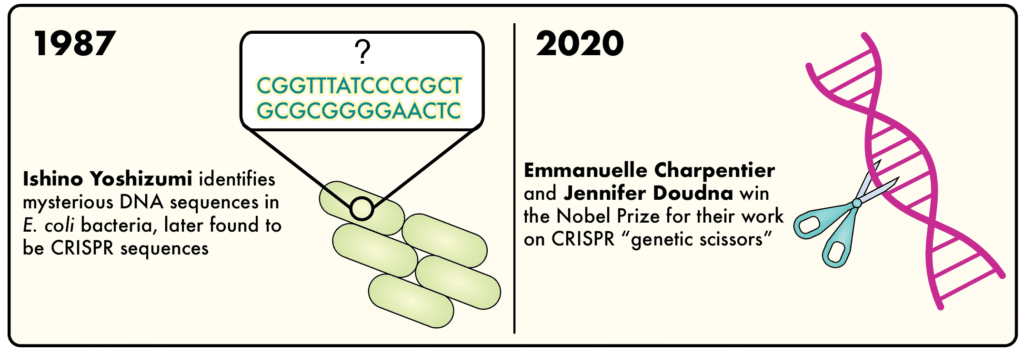
For all the great advances – which are indeed of huge value to the world – one point that is clearly apparent is that all of these Nobel laureates, university presidents and other big names in science from Osaka are male. This gender disparity is reflective of a general worldwide tendency in science and related subjects, but it is especially pronounced in Japan.[104] Part of this is down to limited access to higher education in the past – few universities accepted female students until after the Second World War, before which time a total of only five attended the national university in Osaka – and traditional stereotypes play a role too. It is also relevant that since the war, there have long been barriers to women in Japan entering and remaining in work, which is particularly detrimental to a career in science.[105] Historically, this has affected fields other than the sciences too, and indeed this can be seen throughout the essay. A major reason is that education for girls and women was limited for much of history, even after the modern era began.[106] In the same way that early scholarly writing in Japan is mostly restricted to Buddhist and Confucian studies, the famous intellectuals that have emerged through the ages have generally been the members of society that had the opportunity to learn and discuss ideas. Of course, today’s Japan and today’s Osaka are quite different from what they were decades or centuries ago. In the field of science, there are signs that more female students are enrolling and going further in their studies. There are also more women prominently working at the highest levels: Takahashi Masayo, who grew up in Osaka, made headlines in 2014 when she led the team that performed the first successful transplant using the stem cell techniques pioneered by Yamanaka Shinya.[107] If this is a sign of what is to come from now on, we can expect Osaka’s intellectual future to better reflect the city’s diverse nature.
Summary and Conclusion
Due to Osaka’s long history as one of Japan’s main cities, and especially as one with a distinctive culture based on the heavy influence of the Edo Period merchant class, its thinkers and academics have produced a variety of interesting ideas and innovations. In the classical and mediaeval eras, scholarly works were mostly confined to the fields of Buddhism and Confucianism, and geographically to the capitals in Nara and Kyoto, but this changed over time, leading to the emergence of figures before and during the Edo Period expressing complex views on society and the arts. Particularly in the latter part of the Edo Period, new schools of thought flourished, dealing with national traditions and how they related to Chinese ideas, and with previously unencountered medical and scientific learning. These intellectual developments paved the way in many respects for the modern era, when the conflict between traditional ways and newly imported concepts was at the forefront of many people’s minds. While the 20th century brought debates on subjects like democracy, women’s issues, peace and war, and the environment, at the same time there was further development of the scientific disciplines that were first explored in Osaka’s Edo Period academies. This produced some truly groundbreaking discoveries and innovations, which are sure to have a lasting impact in the future.

Source: Mushi Map http://mushimap.com/tekijyuku/
Throughout history, intellectual trends in Osaka have varied between being individual – distinct, especially from Edo and later Tokyo, and emphasising local culture and values – and part of something bigger – discussions and movements across Japan or the world. These two elements are both vital parts of what makes Osaka what it is, and they probably affected each other: Osaka’s connection to the outside world brought in foreign influences that distinguished it from other places in Japan, and later, its specific mercantile traditions likely helped popularise the city among people coming to Japan. As Osaka’s intellectual history continues from here onward, it will no doubt continue to reflect what is an increasingly cosmopolitan yet somehow distinctive city.
Except where otherwise noted, graphics are by Rachel Stewart (https://www.rachelstewartphd.com/) and other images are photographs taken by the author.
[1] ‘Rise and expansion of Yamato’. Encyclopædia Britannica.
https://www.britannica.com/place/Japan/Rise-and-expansion-of-Yamato
[2] Taylor, I and Taylor, MM, 1995. Writing and Literacy in Chinese, Korean and Japanese. John Benjamins Publishing.
https://books.google.co.jp/books?id=XW9IAAAAQBAJ&printsec=frontcover#v=onepage&q&f=false
[3] Schumacher, M. ‘Shotoku Taishi’. Japanese Buddhist Statuary.
http://www.onmarkproductions.com/html/shotoku-taishi.html
[4] Schumacher, M. ‘Early Japanese Buddhism’. Japanese Buddhist Statuary.
http://www.onmarkproductions.com/html/early-japanese-buddhism.html
[5] ‘Gyoki’. Shikoku Tours.
https://www.shikokutours.com/attractions/people-of-shikoku/Kukai/Gyoki
[6] Schumacher, M. ‘Monju Bosatsu’. Japanese Buddhist Statuary.
http://www.onmarkproductions.com/html/monju.shtml
[7] Kawagoe, A. ‘Ganjin & Gyoki: Monks on a Mission’. Heritage of Japan.
[8] Bellah, R, 1972. ‘Intellectual and Society in Japan’. Daedalus.
https://www.jstor.org/stable/20024072
[9] Holcombe, C, 1997. ‘Ritsuryo Confucianism’. Harvard Journal of Asiatic Studies.
https://www.jstor.org/stable/2719487
[10] ‘Osaka’. The Samurai Archives (archive).
http://web.archive.org/web/20200331103901/https://wiki.samurai-archives.com/index.php?title=Osaka
[11] Graham, P, Yiengpruksawan, M and Miura, M, 2003. ‘Osaka’. Grove Art Online.
[12] Szczepanski, K, 2019. ‘The Four-Tiered Class System of Feudal Japan’. ThoughtCo History & Culture.
https://www.thoughtco.com/four-tiered-class-system-feudal-japan-195582
[13] ‘Ihara Saikaku’. My Poetic Side.
https://mypoeticside.com/poets/ihara-saikaku-poems
[14] Gaubatz, T, 2016. ‘Urban Fictions of Early Modern Japan: Identity, Media, Genre’. Columbia University.
https://academiccommons.columbia.edu/doi/10.7916/D85T3KFV
[15] Johnson, J, 2001. ‘Saikaku and the Narrative Turnabout’. The Journal of Japanese Studies.
https://www.jstor.org/stable/3591969
[16] Harano, J, 2014. ‘The Rich History and Uncertain Future of Bunraku Puppet Theater’. Nippon.com.
https://www.nippon.com/en/column/g00219/
[17] Keene, D, 2021. ‘Chikamatsu Monzaemon’. Encyclopædia Britannica.
https://www.britannica.com/biography/Chikamatsu-Monzaemon
[18] Galay David, K. ‘Three Works of Classical Japanese Literary Criticism’. Academia.edu.
https://www.academia.edu/31020548/Three_works_of_Classical_Japanese_Literary_Criticism
[19] ‘Wagoto’. Kabuki21 Kabuki Glossary.
http://www.kabuki21.com/glossaire_8.php#wagoto
[20] Nasu, E. ‘Rennyo (summary)’. Oxford Research Encyclopedia of Relgion.
https://doi.org/10.1093/acrefore/9780199340378.013.574
[21] 2000. ‘Rennyo Shonin (1415-1499) The Restorer of Jodo-shinshu Buddhism’. Hongwanji International Center – Kyoto.
http://web.mit.edu/stclair/www/rennyo.html
[22] 2017. ‘Ishiyama Hongan-ji Temple: The Temple that Created Osaka’. Kansai Odyssey.
http://kansai-odyssey.com/the-temple-that-created-osaka-ishiyama-hongan-ji-temple/
[23] Dobbins, J, 2021. ‘Shinran’. Encyclopædia Britannica.
https://www.britannica.com/biography/Shinran-Japanese-Buddhist-philosopher
[24] Hoffman, M, 2019. ‘Oshio Heihachiro: Confusing Confucianism’. The Japan Times.
[25] Roberts, G, 1986. ‘Oshio Heihachiro and his revolt of 1837’. Massey University.
https://mro.massey.ac.nz/handle/10179/14247
[26] ‘Oshio Heihachiro’. University of Pittsburgh.
https://www.japanpitt.pitt.edu/glossary/%C5%8Dshio-heihachir%C5%8D
[27] Fujiwara, G and Nosco, P, 2018. ‘The Kokugaku (Native Studies) School’. The Stanford Encyclopedia of Philosophy.
https://plato.stanford.edu/entries/kokugaku-school/
[28] Ichijo, A, 2019. ‘Kokugaku and an alternative account of the emergence of nationalism of Japan’. Journal of the Association for the Study of Ethnicity and Nationalism.
https://onlinelibrary.wiley.com/doi/abs/10.1111/nana.12501
[29] Mori, M, 2006. ‘Keichu’. Kokugakuin University Encyclopedia of Shinto.
http://eos.kokugakuin.ac.jp/modules/xwords/entry.php?entryID=479
[30] Murphy, R, 2009. ‘Esoteric Buddhist Theories of Language in Early Kokugaku: the Soshaku of the Man’yo daishoki’. Japanese Journal of Religious Studies.
https://www.jstor.org/stable/30233854
[31] Ishida, I and Nosco, P, 2020. ‘Kokugaku’. Encyclopedia.com.
https://www.encyclopedia.com/environment/encyclopedias-almanacs-transcripts-and-maps/kokugaku
[32] McLaughlin, M, 2013. ‘An Intellectual Debate: Ueda Akinari and Motoori Norinaga’. Wittenberg University East Asian Studies Journal.
https://core.ac.uk/display/233381089?recSetID=
[33] Burns, S, 2003. Before the Nation: Kokugaku and the Imagining of Community in Early Modern Japan. Duke University Press.
https://read.dukeupress.edu/books/book/813/Before-the-NationKokugaku-and-the-Imagining-of
[34] Larking, M, 2010. ‘Tales of Ueda Akinari and his contemporaries’. The Japan Times.
https://www.japantimes.co.jp/culture/2010/08/20/arts/tales-of-ueda-akinari-and-his-contemporaries/
[35] Caddeau, P, 2006. Appraising Genji: Literary Criticism and Cultural Anxiety in the Age of the Last Samurai. State University of New York Press.
https://ebookcentral.proquest.com/lib/ed/detail.action?docID=3407695
[36] ‘Education at the End of the Shogunate’. MEXT official website.
https://www.mext.go.jp/b_menu/hakusho/html/others/detail/1317225.htm
[37] Kaitokudo Commemoration Society.
http://www.let.osaka-u.ac.jp/kaitokudo/en/index.html
[38] Kinzley, W, 1988. Review of Najita, T. Visions of Virtue in Tokugawa Japan: The Kaitokudo Merchant Academy of Osaka. History of Education Quarterly.
https://www.jstor.org/stable/368288
[39] Bowring, R, 2016. In Search of the Way: Thought and Religion in Early-Modern Japan. Oxford University Press.
[40] Boot, W, 2019. ‘The Reception of Sorai’s Thought in the Second Half of the Edo Period’. In: Boot, W and Takayama, D, ed. Tetsugaku Companion to Ogyu Sorai. Springer.
https://www.springer.com/gp/book/9783030154745
[41] Botsman, D, 1999. ‘Crime, punishment and the making of modern Japan, 1790-1895’. Princeton University.
https://trove.nla.gov.au/work/17745766
[42] Nakayama, S, 2020. ‘Asada Goryu’. Encyclopedia.com.
https://www.encyclopedia.com/people/science-and-technology/astronomy-biographies/asada-goryu
[43] Fernandez, M and Fernandez, P, 1996. ‘Precision Timekeepers of Tokugawa Japan and the Evolution of the Japanese Domestic Clock’. Technology and Culture.
https://www.jstor.org/stable/3106815
[44] Cocks, E and Cocks, J, 1995. Who’s Who on the Moon: A Biographical Dictionary of Lunar Nomenclature. Tudor Publishers.
https://archive.org/details/isbn_9780936389271/
[45] Goodman, G, 2013. Japan and the Dutch 1600-1853. Routledge.
[46] Kato, S, 1967. ‘Tominaga Nakamoto, 1715-46: A Tokugawa Iconoclast’. Monumenta Nipponica.
https://www.jstor.org/stable/2383230
[47] Theodore de Bary, W, et al, 2010. Sources of Japanese Tradition: 1600 to 2000. Columbia University Press.
https://www.vlebooks.com/Vleweb/Product/Index/826449
[48] Fujii, S, 2018. ‘Yamagata Banto: An Atheist in the Tokugawa Period’. Secularism and Nonreligion.
https://www.secularismandnonreligion.org/articles/10.5334/snr.90/
[49] ‘Yamagata Banto Prize’. Osaka Prefecture official website.
http://www.pref.osaka.lg.jp/bunka/news/bantou-kako.html
[50] ‘Tekijuku’. Osaka University official website.
https://www.osaka-u.ac.jp/en/guide/about/tekijuku/index.html
[51] Murata, M and Hirano, T, 2013. ‘Dialog commemorating 175th Anniversary of Tekijuku’. Osaka University official website.
https://www.osaka-u.ac.jp/en/guide/president/2011_2013/talk
[52] ‘About Ogata Koan’. Tekijuku Commemoration Center.
https://www.tekijuku.osaka-u.ac.jp/en/tekijuku/koan
[53] ‘Fukuzawa Yukichi’. Encyclopædia Britannica.
https://www.britannica.com/biography/Fukuzawa-Yukichi
[54] Najita, T, 1999. ‘Ambiguous Encounters: Ogata Koan and International Studies in Late Tokugawa Osaka’. In: McClain, J and Wakita, O, ed. Osaka, The Merchants’ Capital of Early Modern Japan. Cornell University Press.
https://books.google.co.jp/books?id=yb0rftAN3oQC&printsec=frontcover#v=onepage&q&f=false
[55] ‘A Brief Look into the Life of Keio Founder Yukichi Fukuzawa’. Keio University official website.
https://www.keio.ac.jp/en/about/philosophy/fukuzawa.html
[56] Nishikawa, S, 1993. ‘Fukuzawa Yukichi (1835-1901)’. UNESCO International Bureau of Education.
https://unesdoc.unesco.org/ark:/48223/pf0000103085.locale=en
[57] Hardacre, H, 1986. ‘Creating State Shinto: The Great Promulgation Campaign and the New Religions’. The Journal of Japanese Studies.
https://www.jstor.org/stable/132446
[58] ‘NAKAE Chomin’s ideology and various aspects of the Freedom and People’s Rights Movement’. The National Diet Library.
https://www.ndl.go.jp/france/en/part1/s1_2.html
[59] Kaufman-Osborn, T, 1992. ‘Rousseau in Kimono: Nakae Chomin and the Japanese Enlightenment’. Political Theory.
https://www.jstor.org/stable/191779
[60] ‘History’. The Asahi Shimbun.
https://www.asahi.com/corporate/english/11053815
[61] ‘Asahi shimbun’. Encyclopædia Britannica.
https://www.britannica.com/topic/Asahi-shimbun
[62] Hanneman, M, 1997. ‘Dissent from Within: Hasegawa Nyozekan, Liberal Critic of Fascism’. Monumenta Nipponica.
https://www.jstor.org/stable/2385486
[63] Torrance, R, 2005. ‘Literature and Literacy in Osaka, 1890-1940’. The Journal of Japanese Studies.
https://www.jstor.org/stable/25064534
[64] Sakai Plaza of Rikyu and Akiko official website.
http://www.sakai-rishonomori.com/en/
[65] ‘Yosano Akiko’. Poetry Foundation.
https://www.poetryfoundation.org/poets/yosano-akiko
[66] Rabson, S, 1991. ‘Yosano Akiko on War: To Give One’s Life or Not – A Question of Which War’. The Journal of the Association of Teachers of Japanese.
https://www.jstor.org/stable/488910
[67] Rowley, G, 2001. ‘Yosano Akiko’s Poems “In Praise of The Tale of Genji”’. Monumenta Nipponica.
https://www.jstor.org/stable/3096670
[68] Anderson, M, 2006. ‘Kishida Toshiko and the Rise of the Female Speaker in Meiji Japan’. US-Japan Women’s Journal.
https://www.jstor.org/stable/42771943
[69] ‘Junichiro Tanizaki’. Encyclopedia.com.
[70] Hurley, B, 2013. ‘Toward a New Modern Vernacular: Tanizaki Jun’ichiro, Yamada Yoshio, and Showa Restoration Thought’. The Journal of Japanese Studies.
https://www.jstor.org/stable/24243137
[71] Wei, R, 2018. ‘An Outside and Insider’s Osaka: Osaka in Tanizaki Jun’ichiro and Oda Sakunosuke’s Literature’. University of Oregon.
https://scholarsbank.uoregon.edu/xmlui/handle/1794/23790
[72] Siniawer, E, 2011. ‘Liberalism Undone: Discourses on Political Violence in Interwar Japan’. Modern Asian Studies.
https://www.jstor.org/stable/25835707
[73] Fletcher, M, 1979. ‘Intellectuals and Fascism in Early Showa Japan’. The Journal of Asian Studies.
https://www.jstor.org/stable/2053503
[74] Hanneman, M, 2007. ‘The Old Generation in (Mid) Showa Japan: Hasegawa Nyozekan, Maruyama Masao, and Postwar Thought’. The Historian.
https://www.jstor.org/stable/24453829
[75] Barshay, A, 1992. ‘Imagining Democracy in Postwar Japan: Reflection on Maruyama Masao and Modernism’. The Journal of Japanese Studies.
https://www.jstor.org/stable/132825
[76] Rosenbaum, R, 2007. ‘The “Generation of the Burnt-out Ruins”’. Japanese Studies.
https://doi.org/10.1080/10371390701685062
[77] Tanaka, Y, 2007. ‘Oda Makoto, Beheiren and 14 August 1945: Humanitarian Wrath against Indiscriminate Bombing’. The Asia-Pacific Journal.
https://apjjf.org/-Yuki-Tanaka/2532/article.html
[78] Johnston, K, 2009. ‘“What We Had Instead of Childhoods”: Experience as Remembrance in the Vietnam of Kaiko Takeshi’. University of Massachusetts Amherst.
https://scholarworks.umass.edu/cgi/viewcontent.cgi?article=1368&context=theses
[79] Yoshida, S, 1988. ‘Takeshi Kaiko’s Paradox of Light and Darkness’. World Literature Today.
https://www.jstor.org/stable/40144286
[80] Suttmeier, B, 2018. ‘Eating amid Affluence: Kaiko Takeshi’s Adventures in Food’. In: Stalker, N, ed. Devouring Japan: Global Perspectives on Japanese Culinary Identity. Oxford University Press.
[81] Vanderbilt, G and Okabe, I, 2008. ‘From a Woman Aggressor: Reflections of Japan and the Asia Pacific War’. The Asia-Pacific Journal.
https://apjjf.org/-Okabe-Itsuko/2751/article.html
[82] Mitchell, D, 2008. ‘Masao Abe’s Early Spiritual Journey and his Later Philosophy’. Buddhist-Christian Studies.
https://www.jstor.org/stable/30152931
[83] Heine, S, 2008. ‘Is Masao Abe an Original Thinker?’ Buddhist-Christian Studies.
https://www.jstor.org/stable/30152937
[84] Gardner, W, 2011. ‘The 1970 Osaka Expo and/as Science Fiction’. Review of Japanese Culture and Society.
https://www.jstor.org/stable/42801085
[85] Eng, L, 2002. ‘Otak-who? Technoculture, youth, consumption, and resistance’.
http://www.cjas.org/~leng/otaku.pdf
[86] Condry, I, 2013. The Soul of Anime: Collaborative Creativity and Japan’s Media Success Story. Duke University Press.
https://www.jstor.org/stable/j.ctv11smjf0
[87] Kemmer, N, 1983. ‘Hideki Yukawa: 23 January 1907 – 8 September 1981’. Biographical Memoirs of Fellows of the Royal Society.
https://www.jstor.org/stable/769816
[88] ‘The Russell-Einstein peace manifesto – archive’. The Guardian.
https://www.theguardian.com/world/2016/jul/11/russell-einstein-peace-manifesto-archive-1955
[89] Ashrafi, B, 2004. ‘Oral History Interviews: Yoichiro Nambu’. American Institute of Physics.
https://www.aip.org/history-programs/niels-bohr-library/oral-histories/30538
[90] Jona-Lasinio, G, 2016. ‘Yoichiro Nambu: remembering an unusual physicist, a mentor, and a friend’. Progress of Theoretical and Experimental Physics.
https://academic.oup.com/ptep/article/2016/7/07B102/2330172
[91] Amos, J, 2008. ‘Cosmic imperfections celebrated’. BBC News.
http://news.bbc.co.uk/1/hi/sci/tech/7656538.stm
[92] 2012. ‘The Nobel Prize in Physiology or Medicine 2012 – Press Release’. The Nobel Prize.
https://www.nobelprize.org/prizes/medicine/2012/press-release/
[93] Rogers, K. ‘Shinya Yamanaka’. Encyclopædia Britannica.
https://www.britannica.com/biography/Shinya-Yamanaka
[94] Matsuoka, K, 2019. ‘How chemistry Nobelist Akira Yoshino bucked conventional wisdom to develop the lithium-ion battery’. Chemical & Engineering News.
https://cen.acs.org/energy/energy-storage-/chemistry-Nobelist-Akira-Yoshino-bucked/97/i45
[95] O’Donoghue, J, 2019. ‘Akira Yoshino, winner of Nobel for work on lithium-ion batteries, sees tech as environmental fix’. The Japan Times.
[96] Johnston, E, 2018. ‘Osaka makes final pitch to host 2025 World Expo’. The Japan Times.
https://www.japantimes.co.jp/news/2018/06/14/national/osaka-makes-final-pitch-host-2025-world-expo/
[97] ‘Spotlight on Osaka’. US National Library of Medicine.
https://www.ncbi.nlm.nih.gov/pmc/articles/PMC7094914/
[98] Normile, D, 2011. ‘Japan Prizes Honor Immune and Computer Science Research’. Science.
[99] ‘Years served by OU Presidents’. Osaka University official website.
https://www.osaka-u.ac.jp/en/guide/president/presidents
[100] Matsuo, Y and Akira, S, 2010. ‘Here begins the great revolution in immunology!’ Japan Science and Technology Agency.
https://sangakukan.jst.go.jp/journal/journal_contents/2010/06/articles/1006-02/1006-02_earticle.html
[101] Singh Chawla, D, 2017. ‘Who’s the most influential biomedical scientist? Computer program guided by artificial intelligence says it knows’. Science.
[102] Lowe, D, 2020. ‘A Nobel for CRISPR’. Science.
https://blogs.sciencemag.org/pipeline/archives/2020/10/07/a-nobel-for-crispr
[103] Cohen, J, 2020. ‘CRISPR, the revolutionary genetic “scissors,” honored by Chemistry Nobel’. Science.
[104] Ogawa, M, 2017. ‘History of Women’s Participation in STEM Fields in Japan’. The Research Institute of Asian Women.
http://e-asianwomen.org/_common/do.php?a=full&b=12&bidx=878&aidx=11616
[105] Kuwahara, M, 2001. ‘Japanese Women in Science and Technology’. Minerva.
https://www.jstor.org/stable/41827277
[106] Tocco, M, 2005. ‘Made in Japan: Meiji Women’s Education’. In: Molony, B and Uno, K, ed. Gendering Modern Japanese History. Harvard University Press.
https://www.jstor.org/stable/j.ctt1tg5pmc.5
[107] O’Donoghue, J, 2019. ‘Eye-opener: Japanese doctor’s work with iPS cells puts macular degeneration on notice’. The Japan Times.





